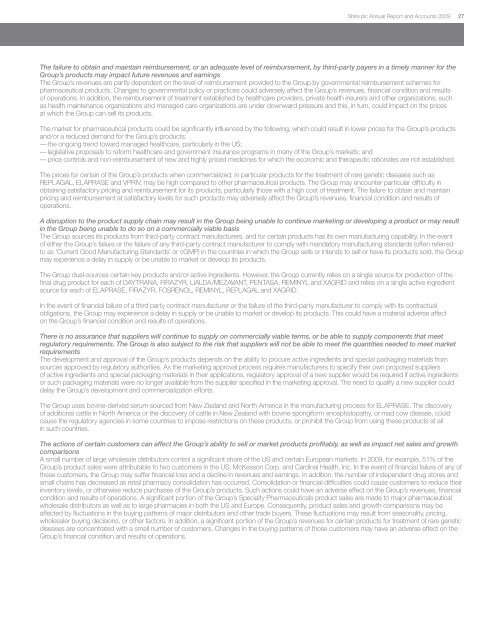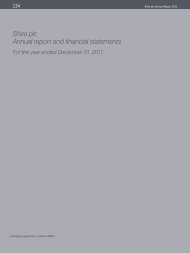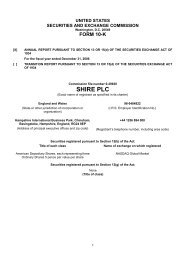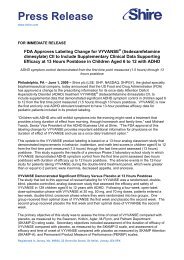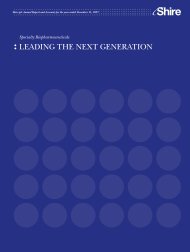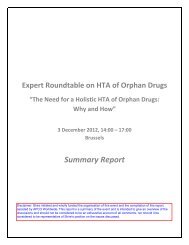7817 Annual Report 2009.qxd - Shire
7817 Annual Report 2009.qxd - Shire
7817 Annual Report 2009.qxd - Shire
You also want an ePaper? Increase the reach of your titles
YUMPU automatically turns print PDFs into web optimized ePapers that Google loves.
<strong>Shire</strong> plc <strong>Annual</strong> <strong>Report</strong> and Accounts 200927The failure to obtain and maintain reimbursement, or an adequate level of reimbursement, by third-party payers in a timely manner for theGroup’s products may impact future revenues and earningsThe Group’s revenues are partly dependent on the level of reimbursement provided to the Group by governmental reimbursement schemes forpharmaceutical products. Changes to governmental policy or practices could adversely affect the Group’s revenues, financial condition and resultsof operations. In addition, the reimbursement of treatment established by healthcare providers, private health insurers and other organizations, suchas health maintenance organizations and managed care organizations are under downward pressure and this, in turn, could impact on the pricesat which the Group can sell its products.The market for pharmaceutical products could be significantly influenced by the following, which could result in lower prices for the Group’s productsand/or a reduced demand for the Group’s products:— the ongoing trend toward managed healthcare, particularly in the US;— legislative proposals to reform healthcare and government insurance programs in many of the Group’s markets; and— price controls and non-reimbursement of new and highly priced medicines for which the economic and therapeutic rationales are not established.The prices for certain of the Group’s products when commercialized, in particular products for the treatment of rare genetic diseases such asREPLAGAL, ELAPRASE and VPRIV, may be high compared to other pharmaceutical products. The Group may encounter particular difficulty inobtaining satisfactory pricing and reimbursement for its products, particularly those with a high cost of treatment. The failure to obtain and maintainpricing and reimbursement at satisfactory levels for such products may adversely affect the Group’s revenues, financial condition and results ofoperations.A disruption to the product supply chain may result in the Group being unable to continue marketing or developing a product or may resultin the Group being unable to do so on a commercially viable basisThe Group sources its products from third-party contract manufacturers, and for certain products has its own manufacturing capability. In the eventof either the Group’s failure or the failure of any third-party contract manufacturer to comply with mandatory manufacturing standards (often referredto as ‘Current Good Manufacturing Standards’ or cGMP) in the countries in which the Group sells or intends to sell or have its products sold, the Groupmay experience a delay in supply or be unable to market or develop its products.The Group dual-sources certain key products and/or active ingredients. However, the Group currently relies on a single source for production of thefinal drug product for each of DAYTRANA, FIRAZYR, LIALDA/MEZAVANT, PENTASA, REMINYL and XAGRID and relies on a single active ingredientsource for each of ELAPRASE, FIRAZYR, FOSRENOL, REMINYL, REPLAGAL and XAGRID.In the event of financial failure of a third party contract manufacturer or the failure of the third-party manufacturer to comply with its contractualobligations, the Group may experience a delay in supply or be unable to market or develop its products. This could have a material adverse affecton the Group’s financial condition and results of operations.There is no assurance that suppliers will continue to supply on commercially viable terms, or be able to supply components that meetregulatory requirements. The Group is also subject to the risk that suppliers will not be able to meet the quantities needed to meet marketrequirementsThe development and approval of the Group’s products depends on the ability to procure active ingredients and special packaging materials fromsources approved by regulatory authorities. As the marketing approval process requires manufacturers to specify their own proposed suppliersof active ingredients and special packaging materials in their applications, regulatory approval of a new supplier would be required if active ingredientsor such packaging materials were no longer available from the supplier specified in the marketing approval. The need to qualify a new supplier coulddelay the Group’s development and commercialization efforts.The Group uses bovine-derived serum sourced from New Zealand and North America in the manufacturing process for ELAPRASE. The discoveryof additional cattle in North America or the discovery of cattle in New Zealand with bovine spongiform encephalopathy, or mad cow disease, couldcause the regulatory agencies in some countries to impose restrictions on these products, or prohibit the Group from using these products at allin such countries.The actions of certain customers can affect the Group’s ability to sell or market products profitably, as well as impact net sales and growthcomparisonsA small number of large wholesale distributors control a significant share of the US and certain European markets. In 2009, for example, 51% of theGroup’s product sales were attributable to two customers in the US; McKesson Corp. and Cardinal Health, Inc. In the event of financial failure of any ofthese customers, the Group may suffer financial loss and a decline in revenues and earnings. In addition, the number of independent drug stores andsmall chains has decreased as retail pharmacy consolidation has occurred. Consolidation or financial difficulties could cause customers to reduce theirinventory levels, or otherwise reduce purchases of the Group’s products. Such actions could have an adverse effect on the Group’s revenues, financialcondition and results of operations. A significant portion of the Group’s Specialty Pharmaceuticals product sales are made to major pharmaceuticalwholesale distributors as well as to large pharmacies in both the US and Europe. Consequently, product sales and growth comparisons may beaffected by fluctuations in the buying patterns of major distributors and other trade buyers. These fluctuations may result from seasonality, pricing,wholesaler buying decisions, or other factors. In addition, a significant portion of the Group’s revenues for certain products for treatment of rare geneticdiseases are concentrated with a small number of customers. Changes in the buying patterns of those customers may have an adverse effect on theGroup’s financial condition and results of operations.


